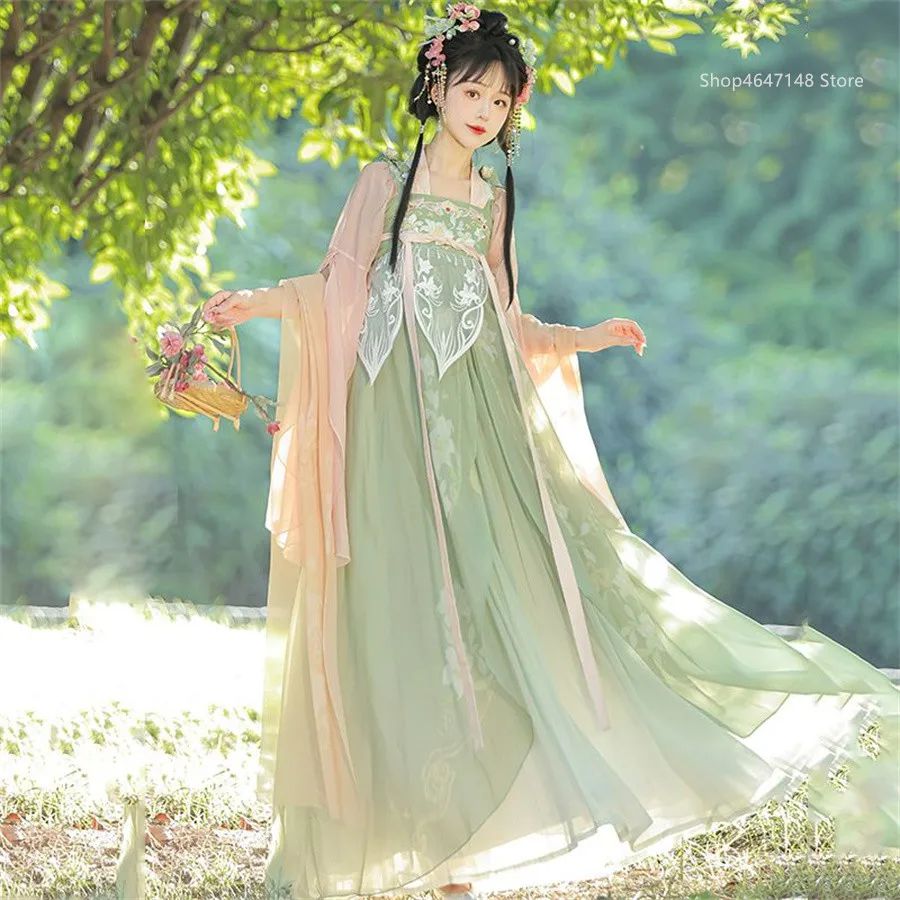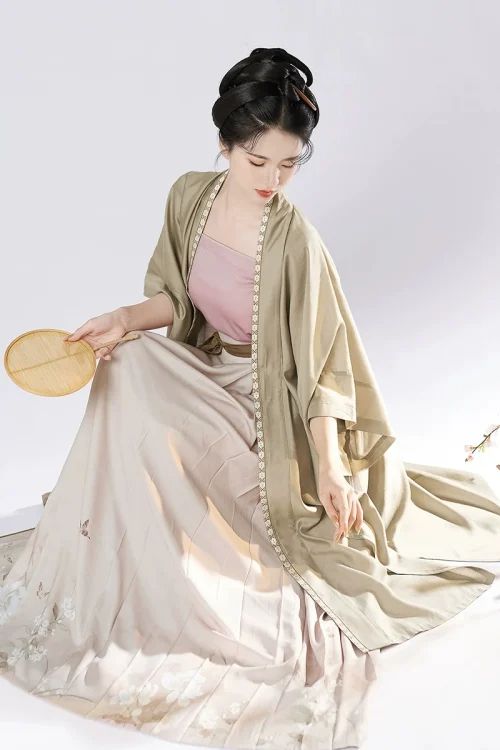Introduction: Hanfu en el Han Dynasty
Hanfu, the traditional clothing of the Han Chinese, has evolved significantly throughout history. Its origins date back to the Han Dynasty (206 BCE – 220 CE), a time of considerable cultural and societal development in China. Hanfu during this period was marked by distinct features that set the foundation for future Chinese attire.
Early Characteristics of Hanfu
During the Han Dynasty, Hanfu was characterized by loose-fitting robes and wide sleeves. The basic outfit consisted of two primary garments: a long robe known as a “yi” and a skirt called a “chang.” Made from silk or hemp, the yi often showcased intricate embroidery and patterns, while the chang, usually made of lighter fabric, was worn over the robe.

The Role of the “Ruqun”
One unique element of Hanfu during this period was the “ruqun,” a jacket worn over the yi. Typically crafted from heavier fabrics, the ruqun featured elaborate designs, serving both practical and decorative purposes. It provided warmth and added a touch of elegance to the overall outfit.
Accessories in Han Dynasty Hanfu
Accessories played an important role in enhancing the Hanfu. Belts, or “dai,” cinched the waist and secured the garments. Headwear, including hats and hairpins, were also common, complementing the overall look. These accessories not only served functional purposes but also contributed to the wearer’s social and aesthetic expression.
Cultural Influences on Hanfu
The Han Dynasty was a time of significant cultural exchange, and Hanfu reflected these influences. For instance, the wide sleeves and flowing robes were likely inspired by the Central Asian nomadic tribes, whose styles gradually permeated Chinese fashion. Additionally, the introduction of Buddhism to China during this period contributed to the incorporation of certain elements of Buddhist clothing into Hanfu, blending spiritual and cultural traditions.
Regional Variations in Hanfu
As the Han Dynasty progressed, Hanfu continued to evolve and diversify. Different regions within China began to develop their own unique variations, reflecting the vast cultural diversity of the empire. Despite these regional differences, certain fundamental characteristics of Hanfu, such as the loose-fitting robes and wide sleeves, remained consistent throughout the dynasty, preserving the core identity of the clothing.
Hanfu as a Symbol of Identity
The Han Dynasty marked a critical period in the development of Hanfu. It was during this era that the essential elements of Hanfu were firmly established, and it began to be recognized as a symbol of Han Chinese identity and cultural heritage. The importance of Hanfu continued to grow, with its legacy enduring through centuries, becoming a vital part of special occasions, festivals, and traditional practices.
The Evolution of Hanfu in the Tang y Song Dynasties
As Hanfu evolved through the centuries, significant developments occurred during the Tang and Song dynasties. These periods saw a refinement of the design and a shift towards practicality, reflecting the changing cultural and societal landscapes.
Tang Dynasty: Elegance and Sophistication
In the Dinastía Tang (618-907), Hanfu reached new heights of elegance and sophistication. The ruling elite favored the ruqun, with its loose-fitting robes and wide sleeves, often crafted from luxurious materials such as silk and brocade. Elaborate embroidery and embellishments adorned these garments, adding to their aesthetic appeal. Women’s ruqun, in particular, featured long, flowing skirts that swept gracefully to the ground, embodying the grandeur and opulence of the era.

Song Dynasty: Simplicity and Functionality
During the Song Dynasty (960-1279), Hanfu became more practical and functional. The garments, including the robes, were narrower and shorter, with tighter sleeves to allow greater mobility. This shift was influenced by the rise of Neo-Confucianism, which promoted simplicity, modesty, and restraint in both thought and attire. Women’s skirts, too, became shorter and more manageable, reflecting a focus on everyday functionality rather than ceremonial grandeur.

The Introduction of the “Beizi”
One of the most notable innovations during the Song Dynasty was the introduction of the “beizi,” a jacket worn over the robe. It provided extra warmth and protection from the elements, making it a practical addition to the Hanfu wardrobe. The beizi became an essential part of Hanfu for both men and women, reflecting the shift towards more utilitarian clothing.
Innovations in Fabrics and Dyeing Techniques
The Song Dynasty also saw significant advancements in fabrics and dyeing techniques. Cotton, which became more widely used during this period, made Hanfu accessible to a broader segment of the population. Additionally, new dyeing methods allowed for a wider array of colors and patterns, enhancing the visual appeal of Hanfu. This period marked a balance between aesthetics and practicality, as clothing became more affordable without sacrificing beauty.
Cultural Reflection in Hanfu’s Evolution
The changes in Hanfu during the Tang and Song dynasties reflected the evolving values and lifestyles of the time. The Tang dynasty’s extravagant designs mirrored the empire’s prosperity and openness, while the Song dynasty’s more restrained styles showcased a society leaning towards simplicity and functionality. These adaptations demonstrate how Hanfu, as a cultural artifact, evolved in response to broader social and philosophical currents.
Legacy of Tang and Song Dynasty Hanfu
The innovations of the Tang and Song dynasties laid the groundwork for the continued evolution of Hanfu in subsequent periods. The refined elegance of Tang Hanfu and the practical functionality of Song Hanfu became integral to the identity of Chinese clothing. Both styles continue to influence modern interpretations of Hanfu, ensuring its lasting legacy as a symbol of Chinese heritage.
Hanfu in the Ming and Qing Dynasties: Adaptation and Transformation
The Ming and Qing dynasties introduced significant transformations in Hanfu, influenced by cultural, social, and political changes. These shifts in fashion marked a new chapter in the evolution of traditional Han Chinese clothing.
Ming Dynasty: Revival and Innovation
During the Ming Dynasty (1368-1644), Hanfu experienced a revival. The ruling Ming emperors, seeking to restore traditional Chinese values, reintroduced and refined Hanfu as a reflection of their cultural agenda. Strict regulations were established for the design and colors of Hanfu, with specific styles reserved for different social ranks and occasions.

Ming Hanfu was notable for its vibrant and bold use of colors such as red, yellow, and green. The garments were often elaborately embroidered with intricate motifs, reflecting the dynasty’s love for luxury and grandeur. Wide, flowing sleeves characterized the elegance of Ming Hanfu, lending an air of nobility to those who wore it.
Qing Dynasty: Influence of the Manchu Style
The Qing Dynasty (1644-1912), ruled by the Manchu people, brought further changes to Hanfu. The Manchus introduced their own clothing style, known as the qipao or cheongsam, which became widely adopted by the population. However, Hanfu remained in use among Han Chinese, though with notable modifications to align with the new political and social landscape.
Subdued Aesthetics and Practical Adjustments
In the Qing Dynasty, Hanfu became more subdued in its color palette and design. The elaborate embroidery and bright colors of the Ming period were replaced with simpler, more understated styles. Garments were crafted from less luxurious materials, and the sleeves became narrower, reflecting the changing tastes of the time. Despite these transformations, Hanfu retained its essential features, such as straight lines and flowing fabrics, without buttons or zippers.
Hanfu’s Persistence Despite Change
Despite the imposition of Manchu culture during the Qing Dynasty, Hanfu remained an important symbol of Han Chinese identity. Scholars, officials, and members of the elite continued to wear it, albeit in a more understated and simplified form. While the Manchu qipao dominated official and courtly attire, Hanfu persisted in everyday life among the Han Chinese population, maintaining its cultural significance.
Hanfu as a Symbol of Chinese Heritage
The evolution of Hanfu throughout the Ming and Qing dynasties highlights the adaptability of traditional Chinese clothing. Even as external influences altered its design, the core elements of Hanfu endured. The flowing fabrics, straight cuts, and emphasis on simplicity and elegance persisted, ensuring that Hanfu continued to be a representation of Han Chinese cultural heritage.
Moderno Renacimiento de Hanfu
In recent years, Hanfu has experienced a resurgence in popularity. People are rediscovering the beauty and significance of traditional clothing, and Hanfu is once again worn during festivals, weddings, and other cultural events. This modern revival reflects a desire to reconnect with Chinese history and cultural roots, showcasing Hanfu’s timeless appeal.

